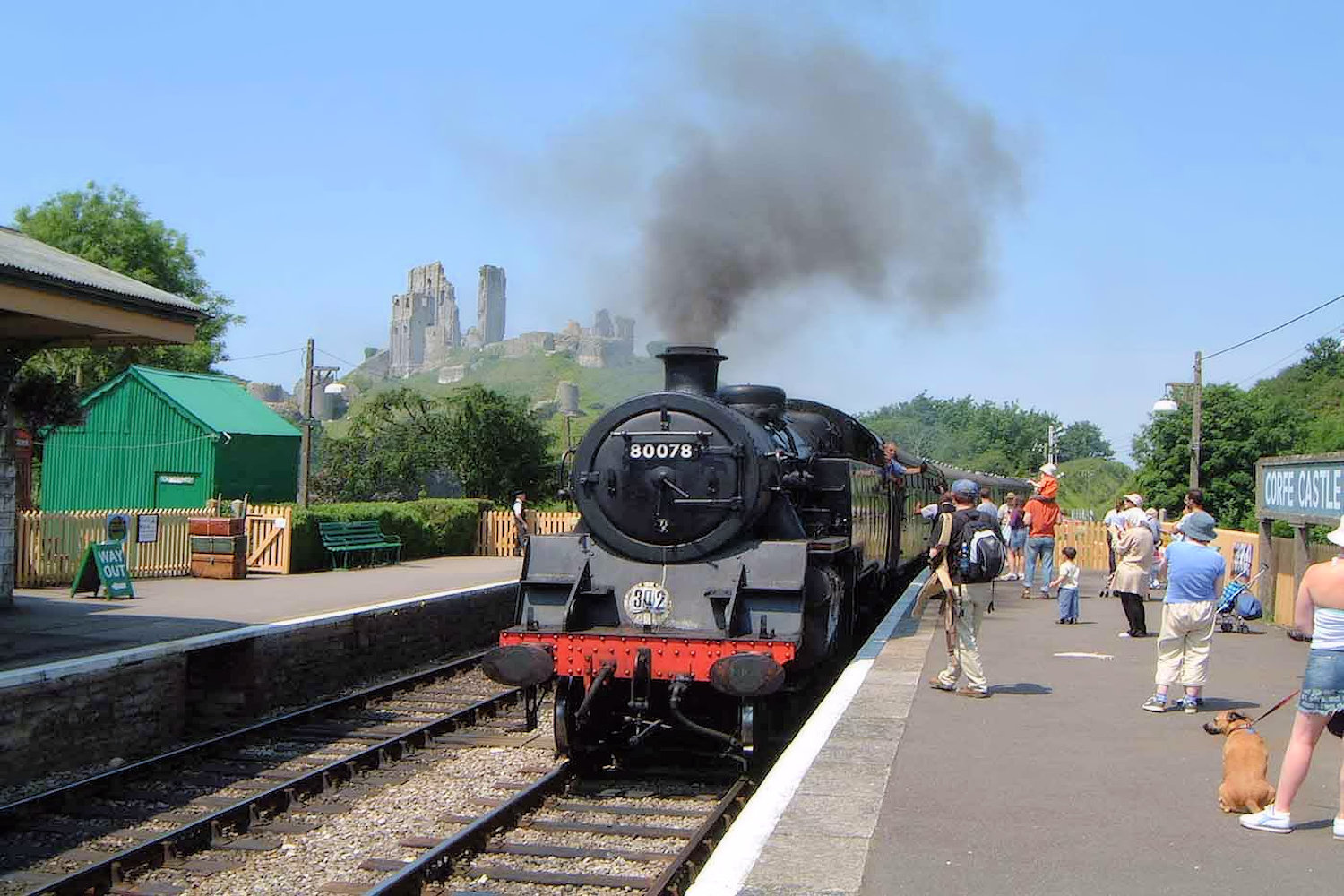The village is constructed almost completely from the local grey Purbeck limestone and comprises two main streets, East Street and West Street, linked at their north end at the Square. Around the square, with its cross commemorating Queen Victoria’s Diamond Jubilee of 1897, are clustered the small collection of shops, the post office, church and pubs.
From the Cretaceous and Jurassic periods when dinosaurs roamed the Isle of Purbeck, right up to the modern day, nearly all periods of history are celebrated in and around the village of Corfe, unequaled in the UK. Experience Corfe Village and the castle on our Jurassic Coast Tour.
Pre-History
Evidence exists on Corfe Common on the southern edge of the village, of a civilisation in 6000 BC. Several barrows (burial mounds) can be seen after leaving West Street onto the common. These people would no doubt have migrated from Europe on the ‘land bridge’ of which the Purbeck hills formed a part.
Roman
The Romans probably dominated Corfe around AD50; however, there is strong evidence of a trading relationship, primarily in copper and pottery, perhaps 100 years earlier. The Romans seemed to have co-existed with the Durotriges as trading partners. There is a Villa under the fields at Bucknowle, and several Roman industrial sites surround the Castle. However, there is legend – later chronicled by Thomas Hardy – of a whole Roman legion disappearing in Purbeck; only its ghost remains. Nevertheless, a massive battle ensued between the two at Maiden Castle resulting in the destruction of these Celts.
Viking & Saxon
Early in the 5th century, as the Romans left our shores, fierce tribes began attacking from Scandinavia and Germany. The Saxons settled here but the Danes plundered for many centuries. It wasn’t until AD875 that things came to a head; King Alfred the Saxon King struck an agreement with Hubba the Dane, a marriage of convenience, but two years later Halfden broke the truce. A decisive naval battle took place; attacked by Alfred’s ships and hindered by a furious storm, 120 Viking ships sank off Peveril Point near Swanage. To prevent further attacks, Alfred built a castle at “Corffe’s Gate”. In AD978 Queen Elfrida murdered her stepson, King Edward the martyr, here; this was in order to put her own son on the throne, subsequently Ethelred the Unready. This triggered many years of Danish plundering. There is a small section of wall in the West of the Inner Bailey of the Castle of a herring-bone design which is probably part of Elfrida’s palace.
Norman
In AD 1090 following William’s conquest of Britain, the Corfe Norman Castle was begun. William’s son Henry I was crowned in 1100 and developed the castle keep and inner bailey. Henry left no legitimate male heir; his daughter Matilda claimed the throne, reinforced by an alliance with the House of Anjou through her husband Geoffrey Plantagenet. King Steven claimed the throne for the House of Blois and Civil War ensued. Corfe was besieged by Stephen, but Baldwin de Redvers held the castle for the Empress.
The dramatic ruins of Corfe Castle stand on a natural hill guarding the principal route through the Purbeck Hills.
The dramatic ruins of Corfe Castle stand on a natural hill guarding the principal route through the Purbeck Hills. As you can see it guards the gap between the south of Purbeck, where Purbeck marble was once quarried, and the rest of England. Nothing could pass in or out without going past the Castle.

It may have been a defensive site even in Roman times and Corfe Castle certainly has had a colourful history. The first castle buildings would have been built of wood. In 979 King Edward was reputedly murdered by his step-mother so that her own son Ethelred the Unready could become King of England. In the latter half of the 11th Century the Castle was rebuilt in stone by William the Conqueror and for the next six hundred years was a royal fortress used by the monarchs of England and latterly their constables.
By 1572 warfare had changed and Corfe Castle was sold by Queen Elizabeth I to Sir Christopher Hatton, her dancing master and favourite. In 1635 the Castle was bought by Sir John Bankes, who was Lord Chief Justice, as an occasional private residence.
As trouble brewed for Charles I, the Bankes family took up permanent residence. By 1643 most of Dorset was occupied by the Parliamentarians, and Lady Bankes and her supporters successfully withstood a six week long siege. Sir John Bankes died in 1644 and the family endured a series of half-hearted blockades by Parliamentary forces. Late in 1645 Colonel Bingham Governor of Poole started a second siege, and treachery by one of the garrison allowed a Parliamentary force into the castle in February 1646. The Roundheads allowed the family to leave the Castle and then it was systematically destroyed by Parliamentary sappers.
Sir Ralph Bankes, son of Sir John, built a new home, Kingston Lacy House, to the west of Wimborne and managed to gather together many of the plundered possessions to furnish the new house.
The Castle remained in the ownership of the Bankes family until 1982 when it was bequeathed as part of the Kingston Lacy and Corfe Castle Estate to the National Trust by Mr.H J R Bankes.
Credit: https://corfe-castle.co.uk/locations/the-castle/